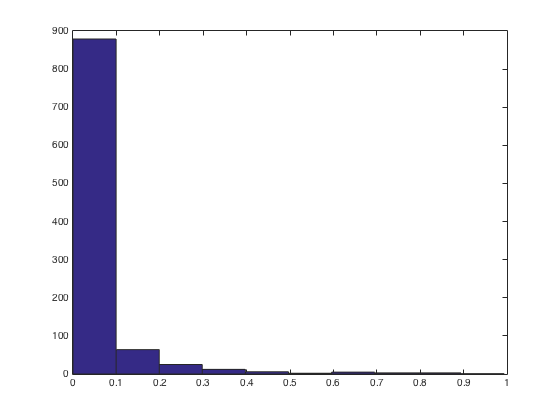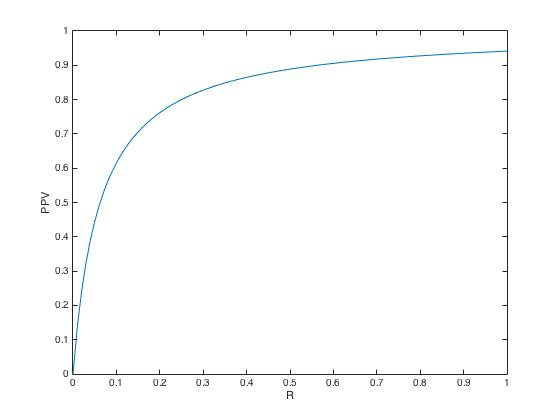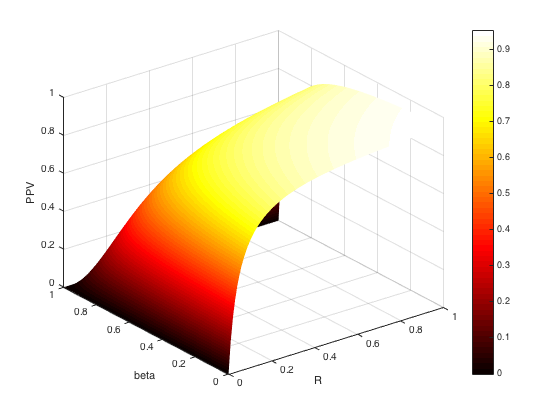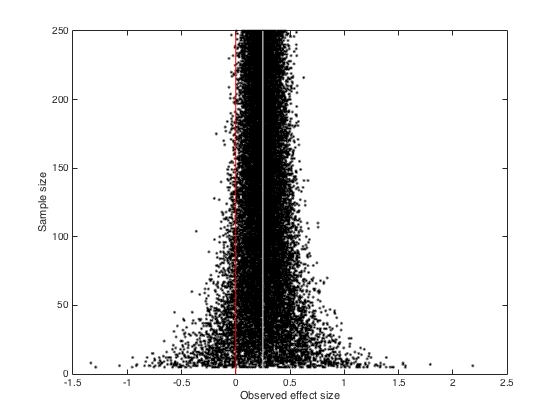Contents
%This lab introduces the notion of simulation to calculate power
1 Init Start with a blank slate
clear all close all clc %Seed the random number generator s = RandStream('mt19937ar','Seed',sum(round(clock))); RandStream.setGlobalStream(s);
2 p values, mean differences and significance
sampleSize = 253; %This will control our sample size numRep = 1e3; %This is the number of times we draw randomly meanDifference = 0.25; %This will control the actual difference in means in the population A = randn(numRep,sampleSize,1); %Draw from a random normal distribution with zero mean A(:,:,2) = randn(numRep,sampleSize,1) + meanDifference; %Similar %But with an average mean difference for ii = 1:numRep [H(ii) P(ii)] = ttest2(A(ii,:,1),A(ii,:,2)); %Test 1st sheet vs. 2nd sheet with a 2 sample t-test end sum(H) figure hist(P)
ans = 798

3 PPV - "positive predictive value"
%The posterior probability that if something is significant, it is true %1 Case alpha = 0.05; %Classic choice beta = 0.2; %Classic choice - power is 1-beta, we aim for 0.8 R = 0.5; %Whatever - reasonable choice PPV = ((1-beta)*R)/(R-beta*R+alpha) %2 All Rs from 0 to 1 R = 0:0.01:1; %Now, let's let R go from 0 to 1 for ii = 1:length(R) PPV(ii) = ((1-beta)*R(ii))/(R(ii)-beta*R(ii)+alpha); end figure plot(R,PPV) xlabel('R') ylabel('PPV') %3 So far, we "clamped" power at 0.8 - what if we had lower power? %Why might we have lower power? %Because it is hard to get high power if the effect size is low. %Who has the funds to recruit thousands of participants? beta = 1:-0.01:0; %Power = 1 - beta, so we'll have this go from 1 to 0 for ii = 1:length(R) for jj = 1:length(beta) PPV(ii,jj) = ((1-beta(jj))*R(ii))/(R(ii)-beta(jj)*R(ii)+alpha); end end %Let's summarize the entire Ioannidis paper in one figure %linking power, R and PPV figure h = surf(R,beta,PPV); %Make a surface plot set(h,'linestyle','none') %Take the mesh off set(h,'facecolor','interp') %Interpolate colors xlabel('R') ylabel('beta') zlabel('PPV') colorbar colormap('hot')
PPV =
0.8889


4 Funnel plots
%Funnel plots are a meta-analyic tool. They effectivly plot effect size %vs. power. %As you increase power, the effects cluster around the "real" effect %Like in a funnel. Hence funnel plot %There are more things to see in funnel plots. %We'll write them here once we did a couple. %But let's first develop them. sampleSize = 5:250; %In the interest of time. effectSize = 0.25; %Later, we put in a real effect size repeats = 1e2; %I want to save time in class. We do a 100 repeats per sample size %Preallocate %This will contain the mean differences - we do a nested loop. To save %time, we preallocate it in memory. meanDifference = zeros(length(repeats),length(sampleSize)); %Calculations %This will allow us to simulate the observed effect sizes for a given %power. Doing so rr number of times, which will allow us to assess the %spread for rr = 1:repeats %Going through all the repeats for ii = 1:length(sampleSize) %Going through all the sample sizes A = randn(sampleSize(ii),1) + effectSize; %Drawing from a random normal distribution plus effectsize B = randn(sampleSize(ii),1); %Doing it again meanDifference(rr,ii) = mean(A)-mean(B); %Calculating the actual mean difference and putting it in the storage structure end end %To plot this, it is easiest to linearize it first %We could plot this in a for loop as well, but this is exhausting %So let's not do that. Instead, let's linearize first linearizedMeanDifference = meanDifference(:); %Put it all in one vector temp = repmat(sampleSize,[repeats 1]); %Tile the sample size linearizedsampleSize = temp(:); %Same for sample size figure plot(linearizedMeanDifference,linearizedsampleSize,'.','color','k') ylabel('Sample size') xlabel('Observed effect size') set(gcf,'color','w') line([0 0], [0 max(ylim)],'color','r') %No effect line([effectSize effectSize], [0 max(ylim)], 'color', 'w') %Real effect
